Finance Case Study: Financial Analysis of Donald's Juice Shop
VerifiedAdded on 2023/01/06
|14
|2647
|3
Case Study
AI Summary
This finance case study presents a comprehensive analysis of Donald's Juice Shop's financial performance for the year ended June 30, 2020. It begins with the preparation of a trial balance and a worksheet, followed by the creation of an income statement, balance sheet, and the necessary adjusting,...
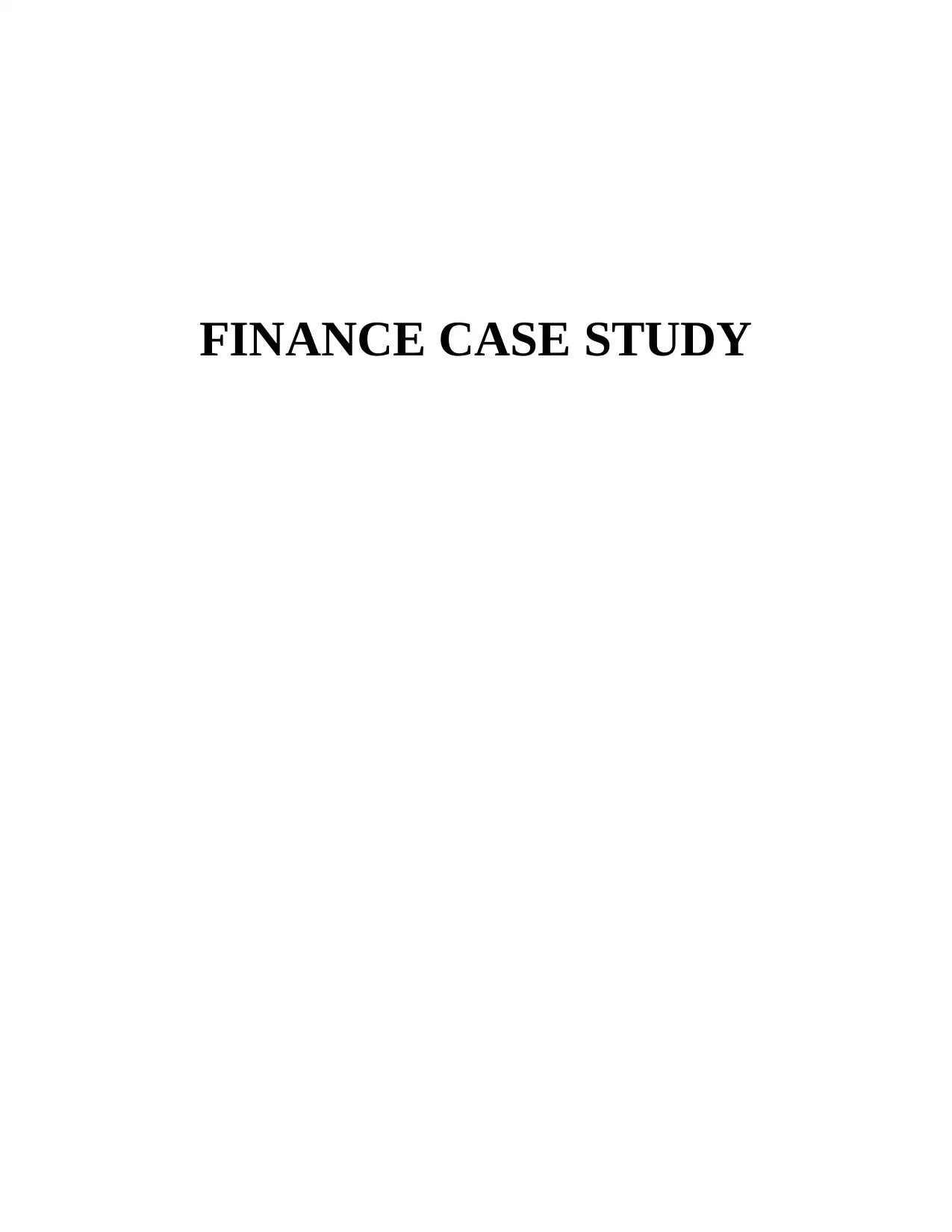
FINANCE CASE STUDY
Paraphrase This Document
Need a fresh take? Get an instant paraphrase of this document with our AI Paraphraser
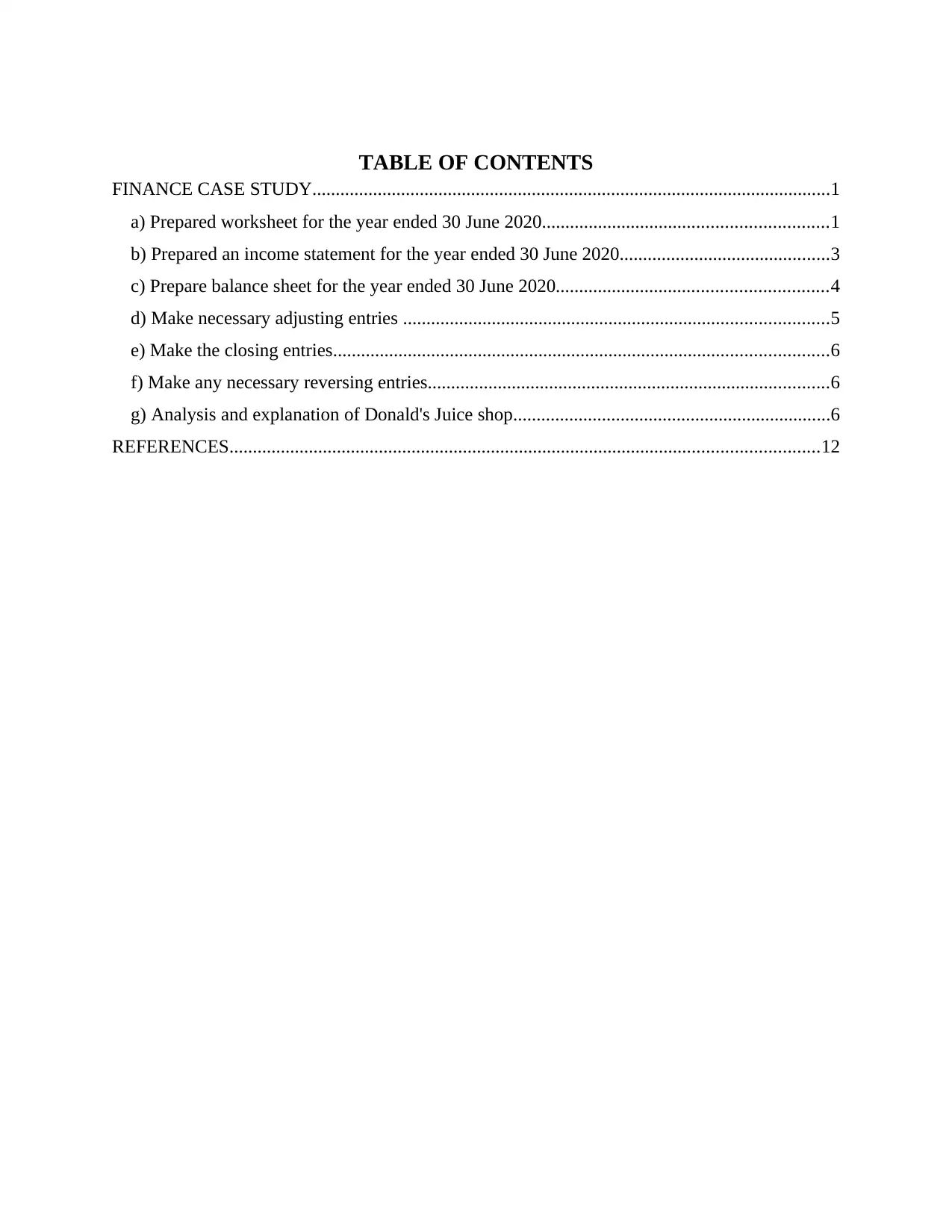
TABLE OF CONTENTS
FINANCE CASE STUDY...............................................................................................................1
a) Prepared worksheet for the year ended 30 June 2020.............................................................1
b) Prepared an income statement for the year ended 30 June 2020.............................................3
c) Prepare balance sheet for the year ended 30 June 2020..........................................................4
d) Make necessary adjusting entries ...........................................................................................5
e) Make the closing entries..........................................................................................................6
f) Make any necessary reversing entries......................................................................................6
g) Analysis and explanation of Donald's Juice shop....................................................................6
REFERENCES..............................................................................................................................12
FINANCE CASE STUDY...............................................................................................................1
a) Prepared worksheet for the year ended 30 June 2020.............................................................1
b) Prepared an income statement for the year ended 30 June 2020.............................................3
c) Prepare balance sheet for the year ended 30 June 2020..........................................................4
d) Make necessary adjusting entries ...........................................................................................5
e) Make the closing entries..........................................................................................................6
f) Make any necessary reversing entries......................................................................................6
g) Analysis and explanation of Donald's Juice shop....................................................................6
REFERENCES..............................................................................................................................12
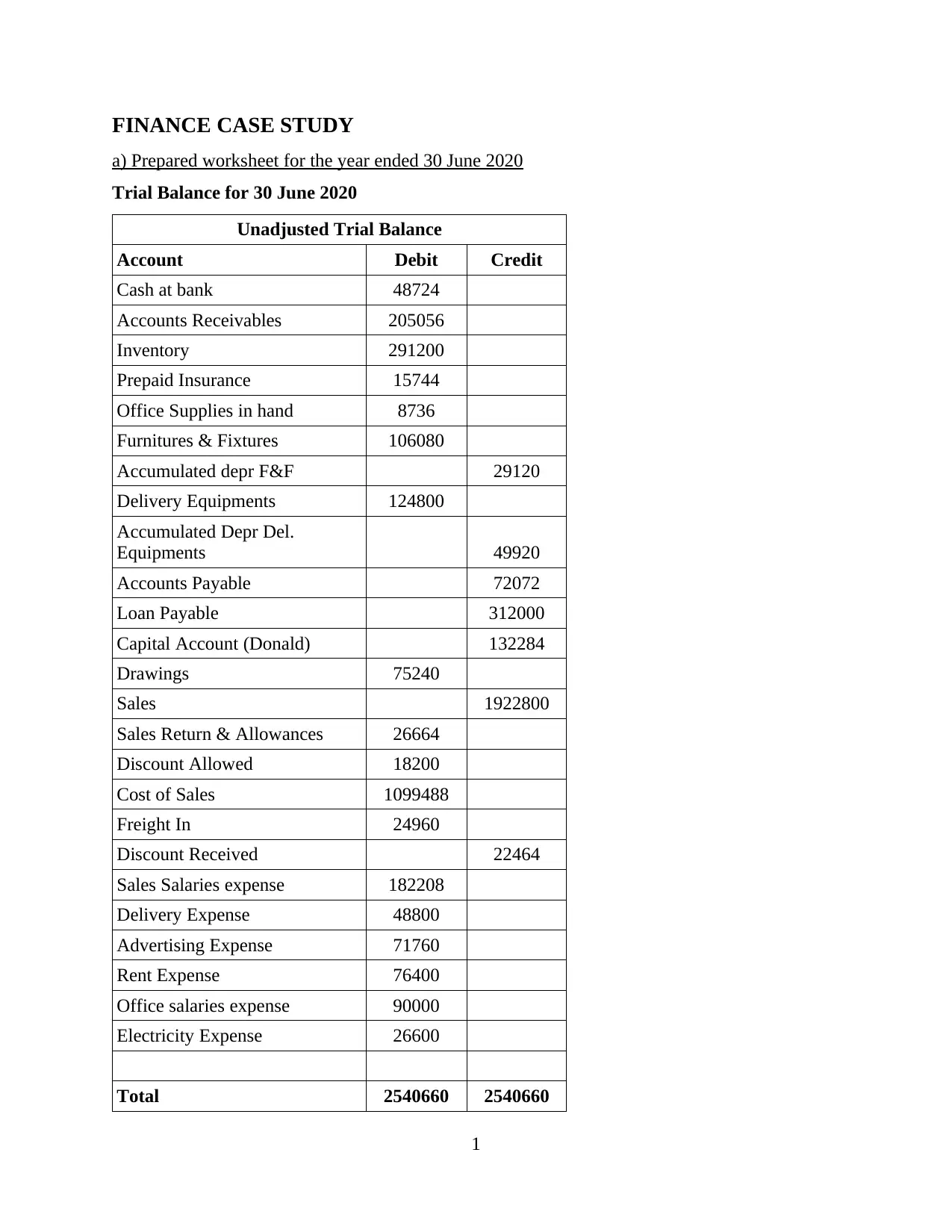
FINANCE CASE STUDY
a) Prepared worksheet for the year ended 30 June 2020
Trial Balance for 30 June 2020
Unadjusted Trial Balance
Account Debit Credit
Cash at bank 48724
Accounts Receivables 205056
Inventory 291200
Prepaid Insurance 15744
Office Supplies in hand 8736
Furnitures & Fixtures 106080
Accumulated depr F&F 29120
Delivery Equipments 124800
Accumulated Depr Del.
Equipments 49920
Accounts Payable 72072
Loan Payable 312000
Capital Account (Donald) 132284
Drawings 75240
Sales 1922800
Sales Return & Allowances 26664
Discount Allowed 18200
Cost of Sales 1099488
Freight In 24960
Discount Received 22464
Sales Salaries expense 182208
Delivery Expense 48800
Advertising Expense 71760
Rent Expense 76400
Office salaries expense 90000
Electricity Expense 26600
Total 2540660 2540660
1
a) Prepared worksheet for the year ended 30 June 2020
Trial Balance for 30 June 2020
Unadjusted Trial Balance
Account Debit Credit
Cash at bank 48724
Accounts Receivables 205056
Inventory 291200
Prepaid Insurance 15744
Office Supplies in hand 8736
Furnitures & Fixtures 106080
Accumulated depr F&F 29120
Delivery Equipments 124800
Accumulated Depr Del.
Equipments 49920
Accounts Payable 72072
Loan Payable 312000
Capital Account (Donald) 132284
Drawings 75240
Sales 1922800
Sales Return & Allowances 26664
Discount Allowed 18200
Cost of Sales 1099488
Freight In 24960
Discount Received 22464
Sales Salaries expense 182208
Delivery Expense 48800
Advertising Expense 71760
Rent Expense 76400
Office salaries expense 90000
Electricity Expense 26600
Total 2540660 2540660
1
⊘ This is a preview!⊘
Do you want full access?
Subscribe today to unlock all pages.

Trusted by 1+ million students worldwide
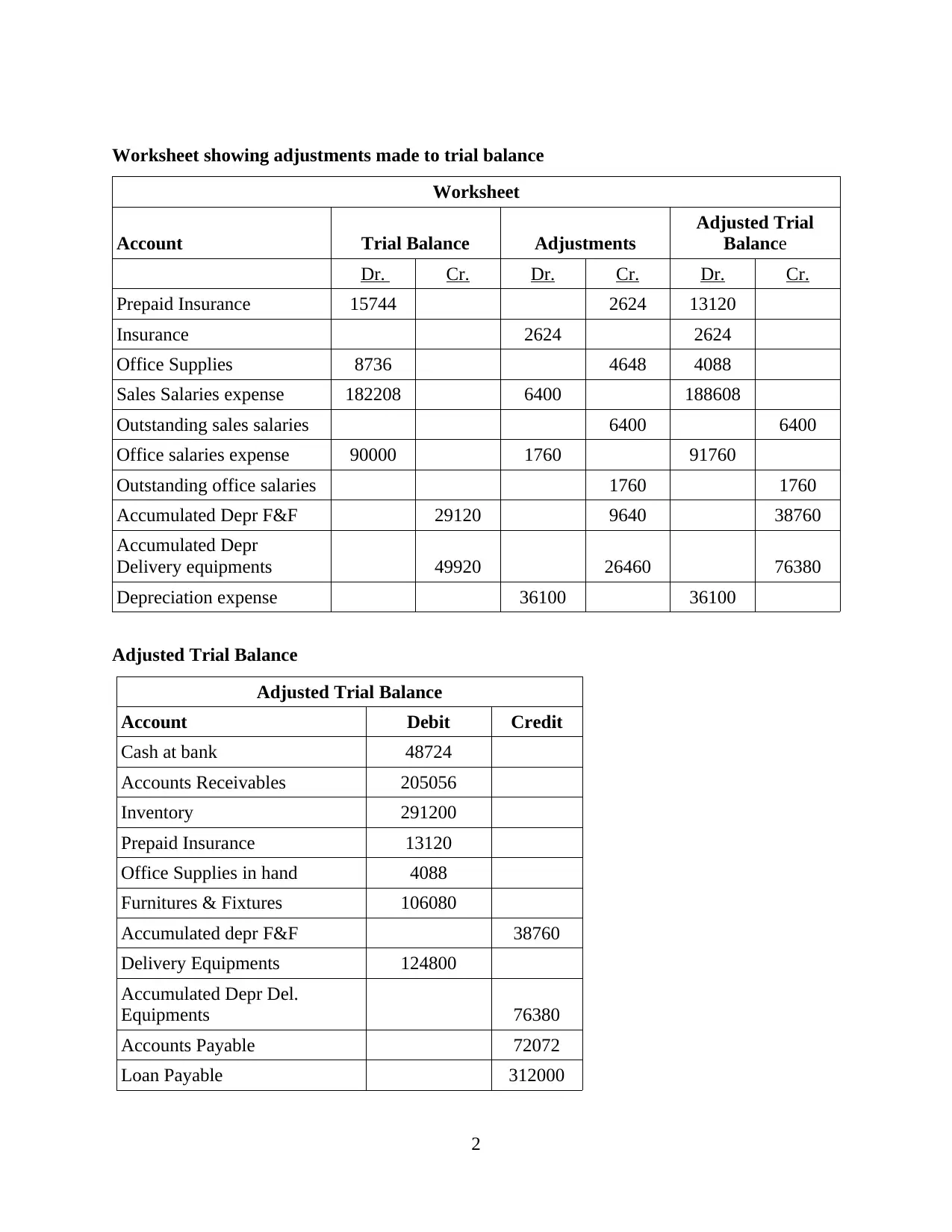
Worksheet showing adjustments made to trial balance
Worksheet
Account Trial Balance Adjustments
Adjusted Trial
Balance
Dr. Cr. Dr. Cr. Dr. Cr.
Prepaid Insurance 15744 2624 13120
Insurance 2624 2624
Office Supplies 8736 4648 4088
Sales Salaries expense 182208 6400 188608
Outstanding sales salaries 6400 6400
Office salaries expense 90000 1760 91760
Outstanding office salaries 1760 1760
Accumulated Depr F&F 29120 9640 38760
Accumulated Depr
Delivery equipments 49920 26460 76380
Depreciation expense 36100 36100
Adjusted Trial Balance
Adjusted Trial Balance
Account Debit Credit
Cash at bank 48724
Accounts Receivables 205056
Inventory 291200
Prepaid Insurance 13120
Office Supplies in hand 4088
Furnitures & Fixtures 106080
Accumulated depr F&F 38760
Delivery Equipments 124800
Accumulated Depr Del.
Equipments 76380
Accounts Payable 72072
Loan Payable 312000
2
Worksheet
Account Trial Balance Adjustments
Adjusted Trial
Balance
Dr. Cr. Dr. Cr. Dr. Cr.
Prepaid Insurance 15744 2624 13120
Insurance 2624 2624
Office Supplies 8736 4648 4088
Sales Salaries expense 182208 6400 188608
Outstanding sales salaries 6400 6400
Office salaries expense 90000 1760 91760
Outstanding office salaries 1760 1760
Accumulated Depr F&F 29120 9640 38760
Accumulated Depr
Delivery equipments 49920 26460 76380
Depreciation expense 36100 36100
Adjusted Trial Balance
Adjusted Trial Balance
Account Debit Credit
Cash at bank 48724
Accounts Receivables 205056
Inventory 291200
Prepaid Insurance 13120
Office Supplies in hand 4088
Furnitures & Fixtures 106080
Accumulated depr F&F 38760
Delivery Equipments 124800
Accumulated Depr Del.
Equipments 76380
Accounts Payable 72072
Loan Payable 312000
2
Paraphrase This Document
Need a fresh take? Get an instant paraphrase of this document with our AI Paraphraser

Capital Account (Donald) 132284
Drawings 75240
Sales 1922800
Sales Return & Allowances 26664
Discount Allowed 18200
Cost of Sales 1099488
Freight In 24960
Discount Received 22464
Sales Salaries expense 188608
Outstanding Sales Salaries
expense 6400
Delivery Expense 48800
Advertising Expense 71760
Rent Expense 76400
Office salaries expense 91760
Outstanding office salaries
expense 1760
Office supplies expense 4648
Insurance 2624
Depreciation expense F& F 9640
Depreciation expense deli.
Equipment 26460
Electricity Expense 26600
Total 2584920 2584920
b) Prepared an income statement for the year ended 30 June 2020
Income Statement
Particulars Amount Amount
Sales 1922800
Sales Return & Allowances 26664 1896136
Cost of Sales -1099488
Freight In -24960
Discount Received 22464
3
Drawings 75240
Sales 1922800
Sales Return & Allowances 26664
Discount Allowed 18200
Cost of Sales 1099488
Freight In 24960
Discount Received 22464
Sales Salaries expense 188608
Outstanding Sales Salaries
expense 6400
Delivery Expense 48800
Advertising Expense 71760
Rent Expense 76400
Office salaries expense 91760
Outstanding office salaries
expense 1760
Office supplies expense 4648
Insurance 2624
Depreciation expense F& F 9640
Depreciation expense deli.
Equipment 26460
Electricity Expense 26600
Total 2584920 2584920
b) Prepared an income statement for the year ended 30 June 2020
Income Statement
Particulars Amount Amount
Sales 1922800
Sales Return & Allowances 26664 1896136
Cost of Sales -1099488
Freight In -24960
Discount Received 22464
3
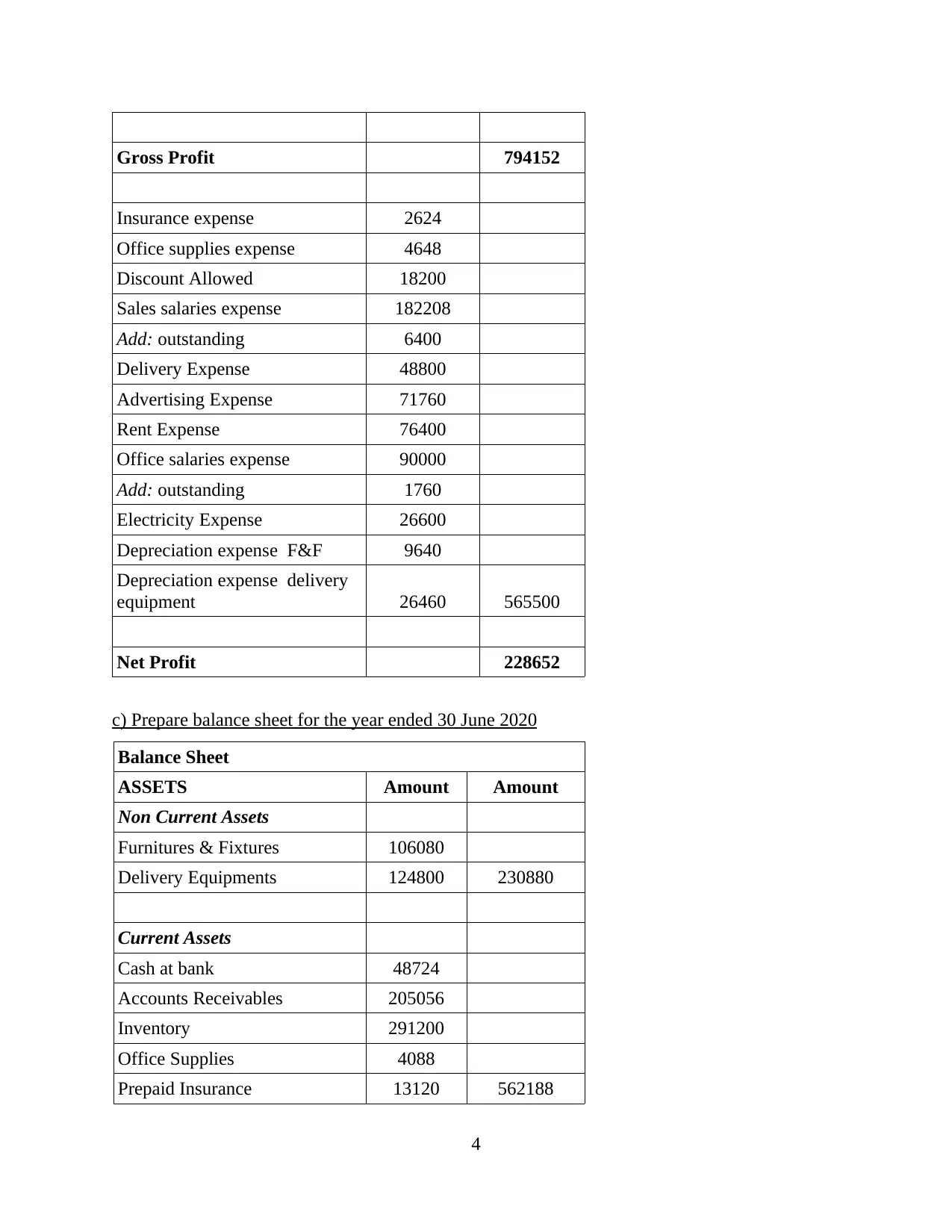
Gross Profit 794152
Insurance expense 2624
Office supplies expense 4648
Discount Allowed 18200
Sales salaries expense 182208
Add: outstanding 6400
Delivery Expense 48800
Advertising Expense 71760
Rent Expense 76400
Office salaries expense 90000
Add: outstanding 1760
Electricity Expense 26600
Depreciation expense F&F 9640
Depreciation expense delivery
equipment 26460 565500
Net Profit 228652
c) Prepare balance sheet for the year ended 30 June 2020
Balance Sheet
ASSETS Amount Amount
Non Current Assets
Furnitures & Fixtures 106080
Delivery Equipments 124800 230880
Current Assets
Cash at bank 48724
Accounts Receivables 205056
Inventory 291200
Office Supplies 4088
Prepaid Insurance 13120 562188
4
Insurance expense 2624
Office supplies expense 4648
Discount Allowed 18200
Sales salaries expense 182208
Add: outstanding 6400
Delivery Expense 48800
Advertising Expense 71760
Rent Expense 76400
Office salaries expense 90000
Add: outstanding 1760
Electricity Expense 26600
Depreciation expense F&F 9640
Depreciation expense delivery
equipment 26460 565500
Net Profit 228652
c) Prepare balance sheet for the year ended 30 June 2020
Balance Sheet
ASSETS Amount Amount
Non Current Assets
Furnitures & Fixtures 106080
Delivery Equipments 124800 230880
Current Assets
Cash at bank 48724
Accounts Receivables 205056
Inventory 291200
Office Supplies 4088
Prepaid Insurance 13120 562188
4
⊘ This is a preview!⊘
Do you want full access?
Subscribe today to unlock all pages.

Trusted by 1+ million students worldwide

Total Assets 793068
EQUITY & LIABILITIES
Owner's Equity 132284
less: drawings -75240
add: Profit 228652 285696
Liabilities
Non Current Liabilities
Loan Payable 312000
Accumulated Depr F&F 38760
Accumulated Depr Del.
Equipments 76380 427140
Current Liabilities
Accounts Payable 72072
Outstanding Sales Salaries 6400
Outstanding office salaries 1760 80232
Total Liabilities 507372
Total Equity & Liabilities 793068
d) Make necessary adjusting entries
Adjusting Journal Entries
Particulars Debit Credit
Insurance expense 2624
To Prepaid Insurance 2624
Profit or Loss 4648
To Office Supplies 4648
5
EQUITY & LIABILITIES
Owner's Equity 132284
less: drawings -75240
add: Profit 228652 285696
Liabilities
Non Current Liabilities
Loan Payable 312000
Accumulated Depr F&F 38760
Accumulated Depr Del.
Equipments 76380 427140
Current Liabilities
Accounts Payable 72072
Outstanding Sales Salaries 6400
Outstanding office salaries 1760 80232
Total Liabilities 507372
Total Equity & Liabilities 793068
d) Make necessary adjusting entries
Adjusting Journal Entries
Particulars Debit Credit
Insurance expense 2624
To Prepaid Insurance 2624
Profit or Loss 4648
To Office Supplies 4648
5
Paraphrase This Document
Need a fresh take? Get an instant paraphrase of this document with our AI Paraphraser

Sales Salaries expense 6400
To outstanding sales salaries 6400
Office salaries expense 1760
To outstanding office salaries 1760
e) Make the closing entries
Closing Journal Entries
Particulars Debit Credit
Depreciation expense 9640
To Furnitures & Fixtures 9640
Depreciation expense 26460
To Delivery Equipments 26460
f) Make any necessary reversing entries
Reversing Journal Entries
Particulars Debit Credit
Insurance expense 2624
To Prepaid Insurance 2624
g) Analysis and explanation of Donald's Juice shop
Donald's Juice Shop is producer of Juice packs. The financial performance and position
of the company could be analysed using ratio analysis. Ratio analysis is the tool used by the
analysts and experts to identify the financial health and efficiency of the management in running
the business. Using the method management and users of financial statements analyse
performance and take measures for improving the profitability and efficiency of the business.
Performance of Juice shop is analysed using ratio analysis for the year ended June 2020.
Particulars Formula 2020
Profitability Ratios
6
To outstanding sales salaries 6400
Office salaries expense 1760
To outstanding office salaries 1760
e) Make the closing entries
Closing Journal Entries
Particulars Debit Credit
Depreciation expense 9640
To Furnitures & Fixtures 9640
Depreciation expense 26460
To Delivery Equipments 26460
f) Make any necessary reversing entries
Reversing Journal Entries
Particulars Debit Credit
Insurance expense 2624
To Prepaid Insurance 2624
g) Analysis and explanation of Donald's Juice shop
Donald's Juice Shop is producer of Juice packs. The financial performance and position
of the company could be analysed using ratio analysis. Ratio analysis is the tool used by the
analysts and experts to identify the financial health and efficiency of the management in running
the business. Using the method management and users of financial statements analyse
performance and take measures for improving the profitability and efficiency of the business.
Performance of Juice shop is analysed using ratio analysis for the year ended June 2020.
Particulars Formula 2020
Profitability Ratios
6
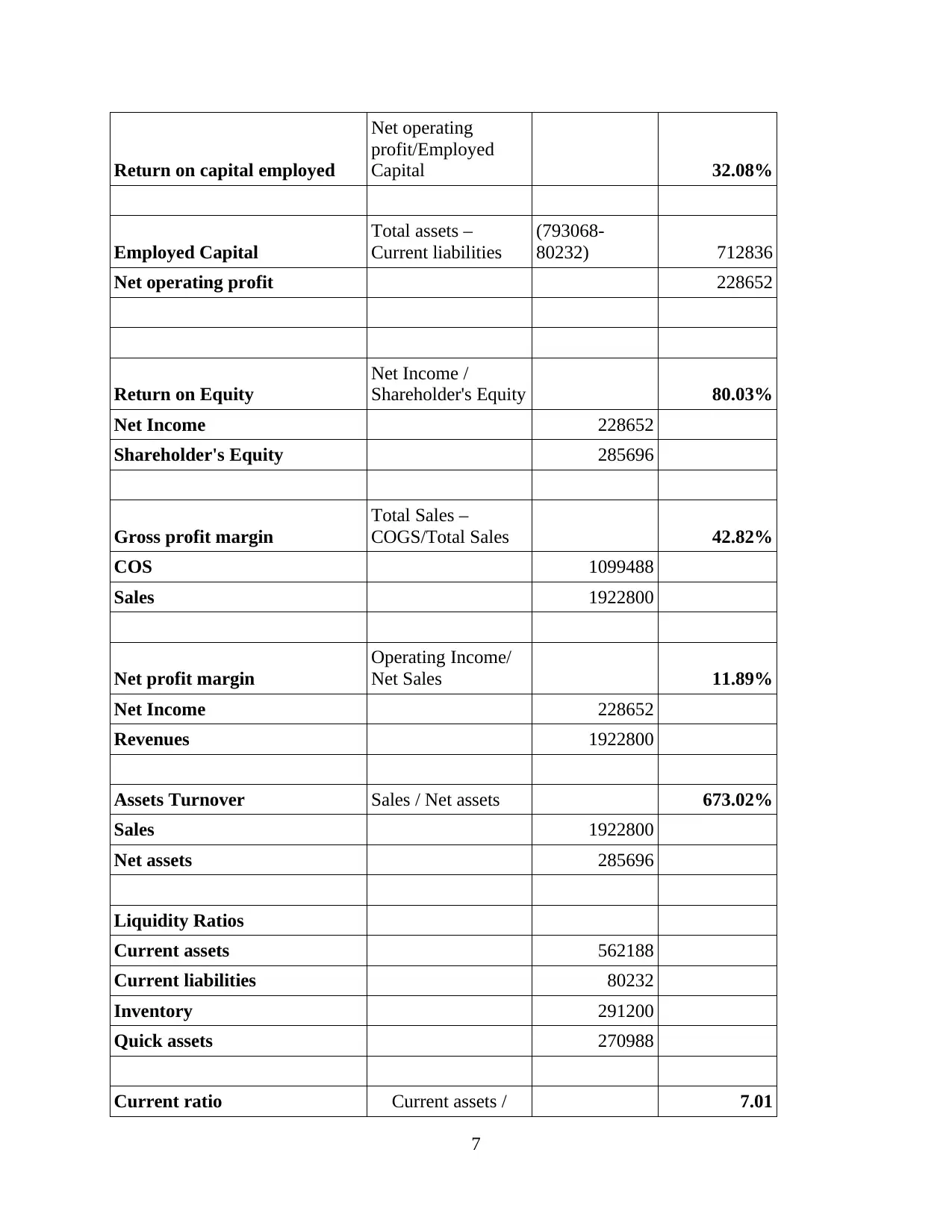
Return on capital employed
Net operating
profit/Employed
Capital 32.08%
Employed Capital
Total assets –
Current liabilities
(793068-
80232) 712836
Net operating profit 228652
Return on Equity
Net Income /
Shareholder's Equity 80.03%
Net Income 228652
Shareholder's Equity 285696
Gross profit margin
Total Sales –
COGS/Total Sales 42.82%
COS 1099488
Sales 1922800
Net profit margin
Operating Income/
Net Sales 11.89%
Net Income 228652
Revenues 1922800
Assets Turnover Sales / Net assets 673.02%
Sales 1922800
Net assets 285696
Liquidity Ratios
Current assets 562188
Current liabilities 80232
Inventory 291200
Quick assets 270988
Current ratio Current assets / 7.01
7
Net operating
profit/Employed
Capital 32.08%
Employed Capital
Total assets –
Current liabilities
(793068-
80232) 712836
Net operating profit 228652
Return on Equity
Net Income /
Shareholder's Equity 80.03%
Net Income 228652
Shareholder's Equity 285696
Gross profit margin
Total Sales –
COGS/Total Sales 42.82%
COS 1099488
Sales 1922800
Net profit margin
Operating Income/
Net Sales 11.89%
Net Income 228652
Revenues 1922800
Assets Turnover Sales / Net assets 673.02%
Sales 1922800
Net assets 285696
Liquidity Ratios
Current assets 562188
Current liabilities 80232
Inventory 291200
Quick assets 270988
Current ratio Current assets / 7.01
7
⊘ This is a preview!⊘
Do you want full access?
Subscribe today to unlock all pages.

Trusted by 1+ million students worldwide
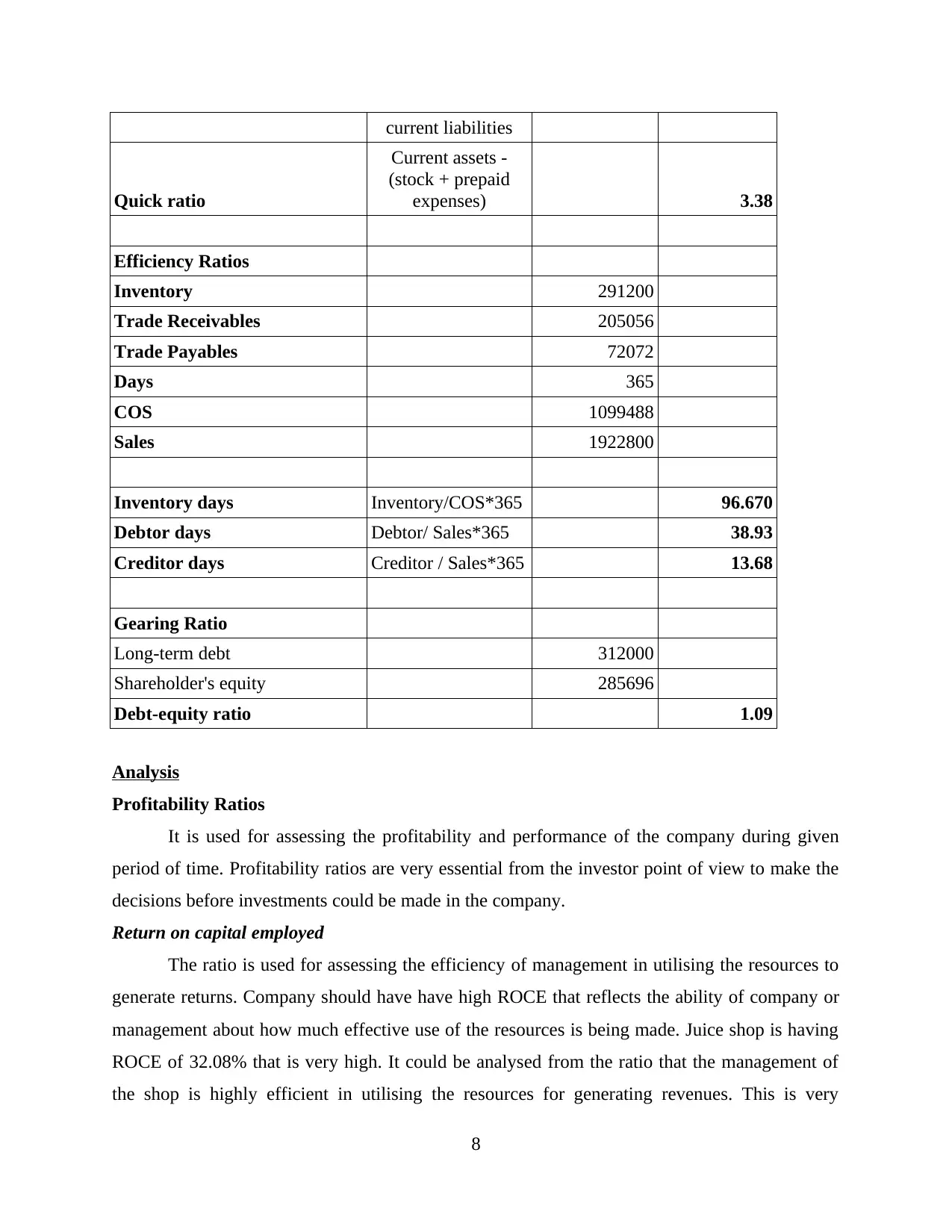
current liabilities
Quick ratio
Current assets -
(stock + prepaid
expenses) 3.38
Efficiency Ratios
Inventory 291200
Trade Receivables 205056
Trade Payables 72072
Days 365
COS 1099488
Sales 1922800
Inventory days Inventory/COS*365 96.670
Debtor days Debtor/ Sales*365 38.93
Creditor days Creditor / Sales*365 13.68
Gearing Ratio
Long-term debt 312000
Shareholder's equity 285696
Debt-equity ratio 1.09
Analysis
Profitability Ratios
It is used for assessing the profitability and performance of the company during given
period of time. Profitability ratios are very essential from the investor point of view to make the
decisions before investments could be made in the company.
Return on capital employed
The ratio is used for assessing the efficiency of management in utilising the resources to
generate returns. Company should have have high ROCE that reflects the ability of company or
management about how much effective use of the resources is being made. Juice shop is having
ROCE of 32.08% that is very high. It could be analysed from the ratio that the management of
the shop is highly efficient in utilising the resources for generating revenues. This is very
8
Quick ratio
Current assets -
(stock + prepaid
expenses) 3.38
Efficiency Ratios
Inventory 291200
Trade Receivables 205056
Trade Payables 72072
Days 365
COS 1099488
Sales 1922800
Inventory days Inventory/COS*365 96.670
Debtor days Debtor/ Sales*365 38.93
Creditor days Creditor / Sales*365 13.68
Gearing Ratio
Long-term debt 312000
Shareholder's equity 285696
Debt-equity ratio 1.09
Analysis
Profitability Ratios
It is used for assessing the profitability and performance of the company during given
period of time. Profitability ratios are very essential from the investor point of view to make the
decisions before investments could be made in the company.
Return on capital employed
The ratio is used for assessing the efficiency of management in utilising the resources to
generate returns. Company should have have high ROCE that reflects the ability of company or
management about how much effective use of the resources is being made. Juice shop is having
ROCE of 32.08% that is very high. It could be analysed from the ratio that the management of
the shop is highly efficient in utilising the resources for generating revenues. This is very
8
Paraphrase This Document
Need a fresh take? Get an instant paraphrase of this document with our AI Paraphraser

essential for the business that the resources are being used over areas that are highly productive
and helping the organisation to generate returns. Juice shop has to maintain the stability over
ROCE to reflect strong management efficiency and to increase the confidence of owner that the
resources are used productively (Laitinen, 2017). Further the management could remove the
assets that are no more productive for the shop to further increase the return. However, very high
ROCE reflects that company is having very low assets and low wealth. The management of the
company has to ensure that the strategies are working effectively to generate returns by keeping
proper monitoring and control over the activities performed. The ratio shows that company is
managing the resources effectively.
Return on Equity
The ratio is used by the experts and analysts to identify the returns generated by the
business over equity investments. Juice Shop is proprietary concern and is not having
shareholders. Donald is the sole owner of shop and is therefore the all the invested equity
belongs to Donald alone. There is no sharing of the profits between different members as there is
single owner. ROE of Juice Shop is 80.03% that is extremely high. The return presents the
business as highly profitable as it is giving 80% return over the capital invested. This could be
interpreted from the ratio that Shop is performing extremely well and generate high returns.
However as this is proprietary concern the capital represented in the books may be from since its
inception. Therefore this ratio could not be relied heavily for evaluating the performance and
profitability of the company. The ROE represents that there are high growth opportunities for the
business (Aulová, Pánková and Rumánková, 2019). It could expand the business over new
areas or regions as the company is having high profits. It could also raise high funds from the
market based on the profits and performance as investors are always seeking companies with
high returns.
Gross Profit Margin
The ratio is used for assessing the ability of company to earn profits after meeting all the
direct expenses for carrying out the business operations. The gross profit margin of Juice Shop is
42.82% that is adequate and reflects that the operations of business are being managed
effectively. The margin of the company is adequate as per the industry standards. However, the
shop could focus over the cost strategies to increase the profits further. Frameworks and methods
that enable the company to produce goods in more cost efficient manner should be adopted
9
and helping the organisation to generate returns. Juice shop has to maintain the stability over
ROCE to reflect strong management efficiency and to increase the confidence of owner that the
resources are used productively (Laitinen, 2017). Further the management could remove the
assets that are no more productive for the shop to further increase the return. However, very high
ROCE reflects that company is having very low assets and low wealth. The management of the
company has to ensure that the strategies are working effectively to generate returns by keeping
proper monitoring and control over the activities performed. The ratio shows that company is
managing the resources effectively.
Return on Equity
The ratio is used by the experts and analysts to identify the returns generated by the
business over equity investments. Juice Shop is proprietary concern and is not having
shareholders. Donald is the sole owner of shop and is therefore the all the invested equity
belongs to Donald alone. There is no sharing of the profits between different members as there is
single owner. ROE of Juice Shop is 80.03% that is extremely high. The return presents the
business as highly profitable as it is giving 80% return over the capital invested. This could be
interpreted from the ratio that Shop is performing extremely well and generate high returns.
However as this is proprietary concern the capital represented in the books may be from since its
inception. Therefore this ratio could not be relied heavily for evaluating the performance and
profitability of the company. The ROE represents that there are high growth opportunities for the
business (Aulová, Pánková and Rumánková, 2019). It could expand the business over new
areas or regions as the company is having high profits. It could also raise high funds from the
market based on the profits and performance as investors are always seeking companies with
high returns.
Gross Profit Margin
The ratio is used for assessing the ability of company to earn profits after meeting all the
direct expenses for carrying out the business operations. The gross profit margin of Juice Shop is
42.82% that is adequate and reflects that the operations of business are being managed
effectively. The margin of the company is adequate as per the industry standards. However, the
shop could focus over the cost strategies to increase the profits further. Frameworks and methods
that enable the company to produce goods in more cost efficient manner should be adopted
9
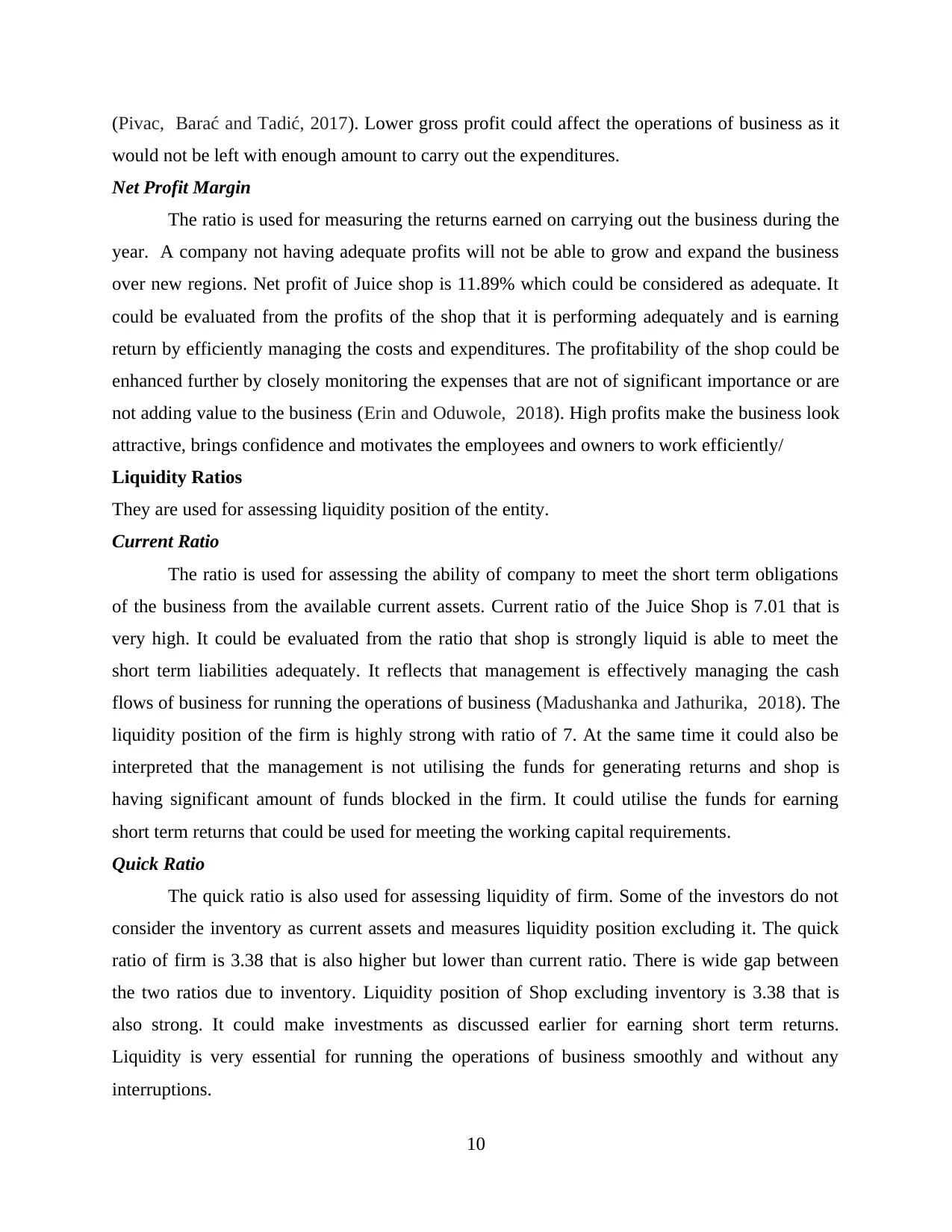
(Pivac, Barać and Tadić, 2017). Lower gross profit could affect the operations of business as it
would not be left with enough amount to carry out the expenditures.
Net Profit Margin
The ratio is used for measuring the returns earned on carrying out the business during the
year. A company not having adequate profits will not be able to grow and expand the business
over new regions. Net profit of Juice shop is 11.89% which could be considered as adequate. It
could be evaluated from the profits of the shop that it is performing adequately and is earning
return by efficiently managing the costs and expenditures. The profitability of the shop could be
enhanced further by closely monitoring the expenses that are not of significant importance or are
not adding value to the business (Erin and Oduwole, 2018). High profits make the business look
attractive, brings confidence and motivates the employees and owners to work efficiently/
Liquidity Ratios
They are used for assessing liquidity position of the entity.
Current Ratio
The ratio is used for assessing the ability of company to meet the short term obligations
of the business from the available current assets. Current ratio of the Juice Shop is 7.01 that is
very high. It could be evaluated from the ratio that shop is strongly liquid is able to meet the
short term liabilities adequately. It reflects that management is effectively managing the cash
flows of business for running the operations of business (Madushanka and Jathurika, 2018). The
liquidity position of the firm is highly strong with ratio of 7. At the same time it could also be
interpreted that the management is not utilising the funds for generating returns and shop is
having significant amount of funds blocked in the firm. It could utilise the funds for earning
short term returns that could be used for meeting the working capital requirements.
Quick Ratio
The quick ratio is also used for assessing liquidity of firm. Some of the investors do not
consider the inventory as current assets and measures liquidity position excluding it. The quick
ratio of firm is 3.38 that is also higher but lower than current ratio. There is wide gap between
the two ratios due to inventory. Liquidity position of Shop excluding inventory is 3.38 that is
also strong. It could make investments as discussed earlier for earning short term returns.
Liquidity is very essential for running the operations of business smoothly and without any
interruptions.
10
would not be left with enough amount to carry out the expenditures.
Net Profit Margin
The ratio is used for measuring the returns earned on carrying out the business during the
year. A company not having adequate profits will not be able to grow and expand the business
over new regions. Net profit of Juice shop is 11.89% which could be considered as adequate. It
could be evaluated from the profits of the shop that it is performing adequately and is earning
return by efficiently managing the costs and expenditures. The profitability of the shop could be
enhanced further by closely monitoring the expenses that are not of significant importance or are
not adding value to the business (Erin and Oduwole, 2018). High profits make the business look
attractive, brings confidence and motivates the employees and owners to work efficiently/
Liquidity Ratios
They are used for assessing liquidity position of the entity.
Current Ratio
The ratio is used for assessing the ability of company to meet the short term obligations
of the business from the available current assets. Current ratio of the Juice Shop is 7.01 that is
very high. It could be evaluated from the ratio that shop is strongly liquid is able to meet the
short term liabilities adequately. It reflects that management is effectively managing the cash
flows of business for running the operations of business (Madushanka and Jathurika, 2018). The
liquidity position of the firm is highly strong with ratio of 7. At the same time it could also be
interpreted that the management is not utilising the funds for generating returns and shop is
having significant amount of funds blocked in the firm. It could utilise the funds for earning
short term returns that could be used for meeting the working capital requirements.
Quick Ratio
The quick ratio is also used for assessing liquidity of firm. Some of the investors do not
consider the inventory as current assets and measures liquidity position excluding it. The quick
ratio of firm is 3.38 that is also higher but lower than current ratio. There is wide gap between
the two ratios due to inventory. Liquidity position of Shop excluding inventory is 3.38 that is
also strong. It could make investments as discussed earlier for earning short term returns.
Liquidity is very essential for running the operations of business smoothly and without any
interruptions.
10
⊘ This is a preview!⊘
Do you want full access?
Subscribe today to unlock all pages.

Trusted by 1+ million students worldwide
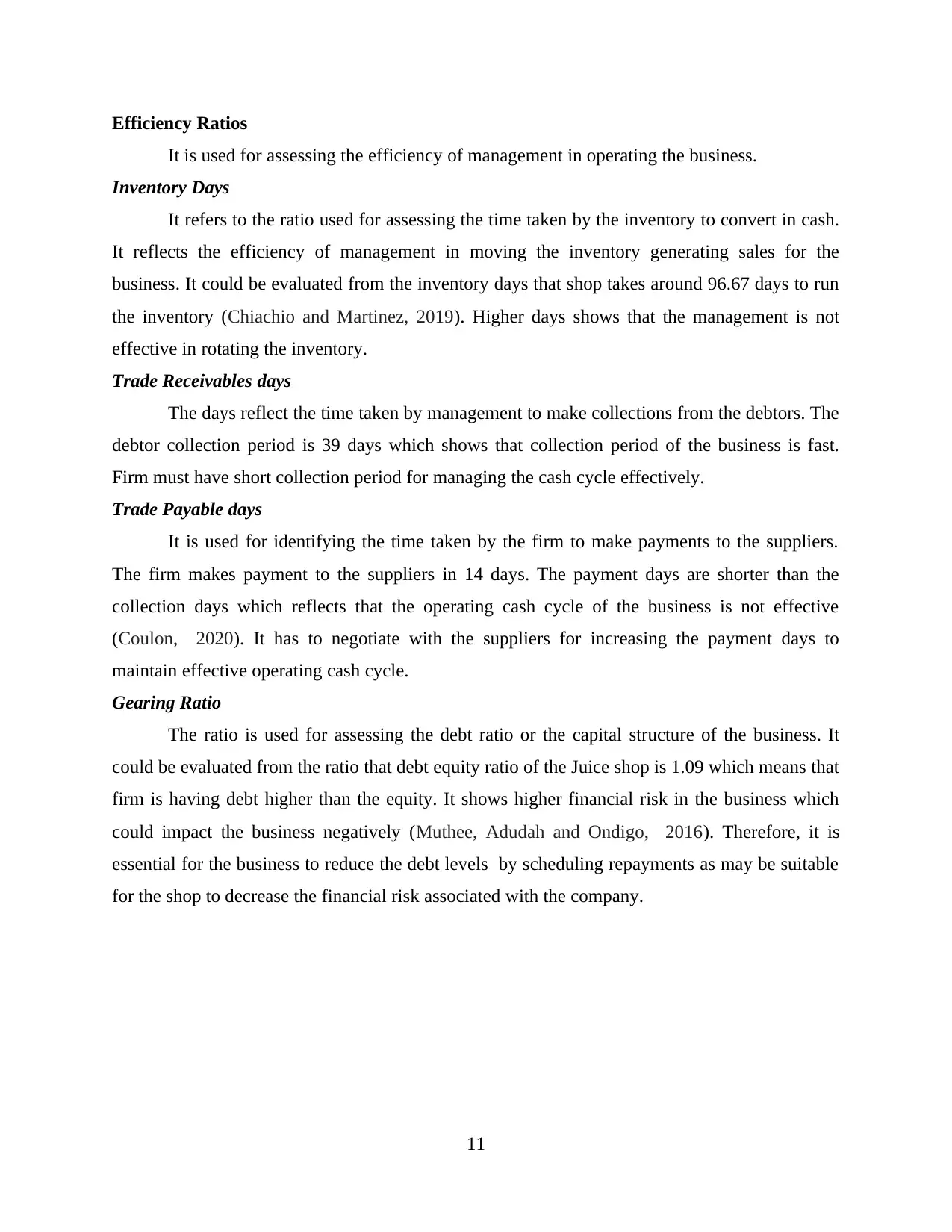
Efficiency Ratios
It is used for assessing the efficiency of management in operating the business.
Inventory Days
It refers to the ratio used for assessing the time taken by the inventory to convert in cash.
It reflects the efficiency of management in moving the inventory generating sales for the
business. It could be evaluated from the inventory days that shop takes around 96.67 days to run
the inventory (Chiachio and Martinez, 2019). Higher days shows that the management is not
effective in rotating the inventory.
Trade Receivables days
The days reflect the time taken by management to make collections from the debtors. The
debtor collection period is 39 days which shows that collection period of the business is fast.
Firm must have short collection period for managing the cash cycle effectively.
Trade Payable days
It is used for identifying the time taken by the firm to make payments to the suppliers.
The firm makes payment to the suppliers in 14 days. The payment days are shorter than the
collection days which reflects that the operating cash cycle of the business is not effective
(Coulon, 2020). It has to negotiate with the suppliers for increasing the payment days to
maintain effective operating cash cycle.
Gearing Ratio
The ratio is used for assessing the debt ratio or the capital structure of the business. It
could be evaluated from the ratio that debt equity ratio of the Juice shop is 1.09 which means that
firm is having debt higher than the equity. It shows higher financial risk in the business which
could impact the business negatively (Muthee, Adudah and Ondigo, 2016). Therefore, it is
essential for the business to reduce the debt levels by scheduling repayments as may be suitable
for the shop to decrease the financial risk associated with the company.
11
It is used for assessing the efficiency of management in operating the business.
Inventory Days
It refers to the ratio used for assessing the time taken by the inventory to convert in cash.
It reflects the efficiency of management in moving the inventory generating sales for the
business. It could be evaluated from the inventory days that shop takes around 96.67 days to run
the inventory (Chiachio and Martinez, 2019). Higher days shows that the management is not
effective in rotating the inventory.
Trade Receivables days
The days reflect the time taken by management to make collections from the debtors. The
debtor collection period is 39 days which shows that collection period of the business is fast.
Firm must have short collection period for managing the cash cycle effectively.
Trade Payable days
It is used for identifying the time taken by the firm to make payments to the suppliers.
The firm makes payment to the suppliers in 14 days. The payment days are shorter than the
collection days which reflects that the operating cash cycle of the business is not effective
(Coulon, 2020). It has to negotiate with the suppliers for increasing the payment days to
maintain effective operating cash cycle.
Gearing Ratio
The ratio is used for assessing the debt ratio or the capital structure of the business. It
could be evaluated from the ratio that debt equity ratio of the Juice shop is 1.09 which means that
firm is having debt higher than the equity. It shows higher financial risk in the business which
could impact the business negatively (Muthee, Adudah and Ondigo, 2016). Therefore, it is
essential for the business to reduce the debt levels by scheduling repayments as may be suitable
for the shop to decrease the financial risk associated with the company.
11
Paraphrase This Document
Need a fresh take? Get an instant paraphrase of this document with our AI Paraphraser
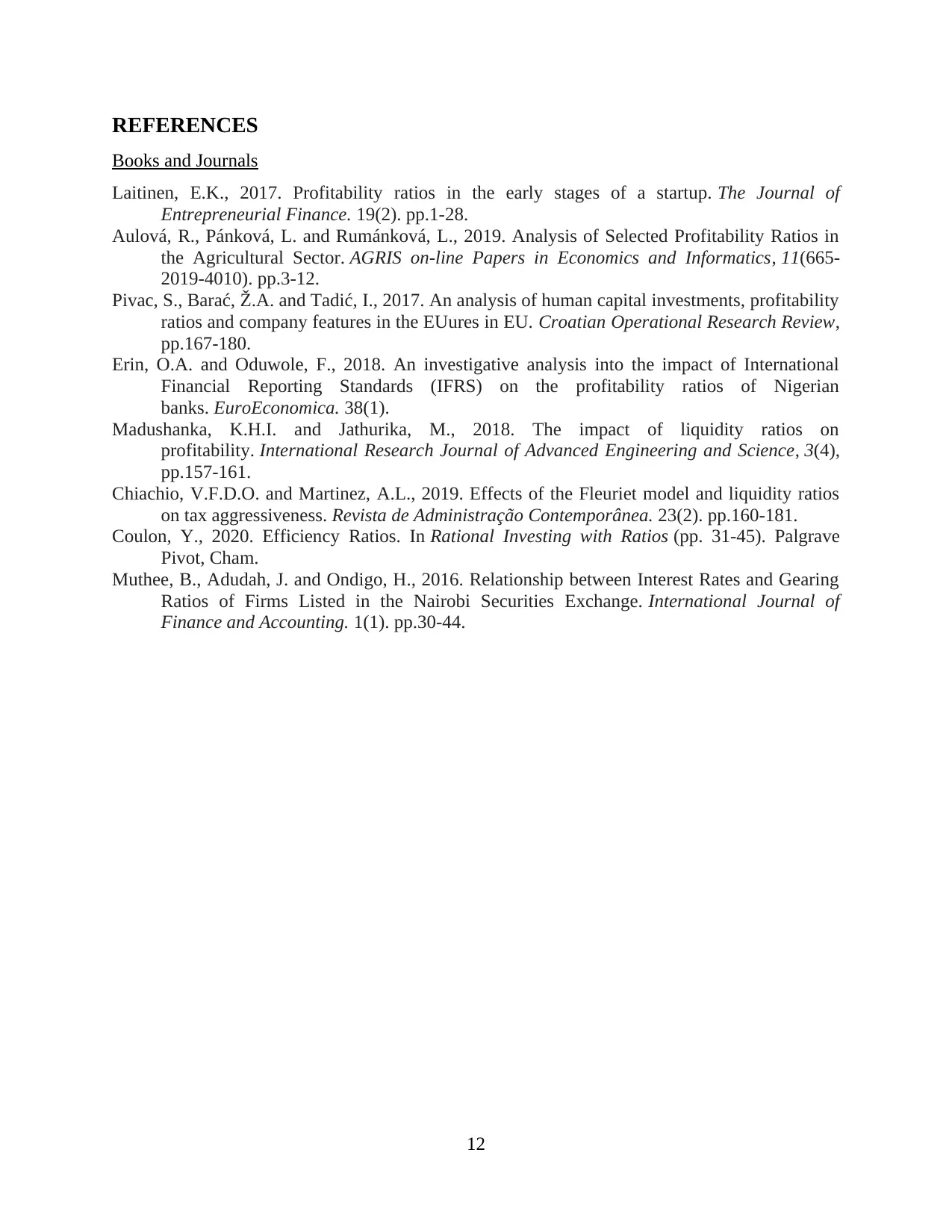
REFERENCES
Books and Journals
Laitinen, E.K., 2017. Profitability ratios in the early stages of a startup. The Journal of
Entrepreneurial Finance. 19(2). pp.1-28.
Aulová, R., Pánková, L. and Rumánková, L., 2019. Analysis of Selected Profitability Ratios in
the Agricultural Sector. AGRIS on-line Papers in Economics and Informatics, 11(665-
2019-4010). pp.3-12.
Pivac, S., Barać, Ž.A. and Tadić, I., 2017. An analysis of human capital investments, profitability
ratios and company features in the EUures in EU. Croatian Operational Research Review,
pp.167-180.
Erin, O.A. and Oduwole, F., 2018. An investigative analysis into the impact of International
Financial Reporting Standards (IFRS) on the profitability ratios of Nigerian
banks. EuroEconomica. 38(1).
Madushanka, K.H.I. and Jathurika, M., 2018. The impact of liquidity ratios on
profitability. International Research Journal of Advanced Engineering and Science, 3(4),
pp.157-161.
Chiachio, V.F.D.O. and Martinez, A.L., 2019. Effects of the Fleuriet model and liquidity ratios
on tax aggressiveness. Revista de Administração Contemporânea. 23(2). pp.160-181.
Coulon, Y., 2020. Efficiency Ratios. In Rational Investing with Ratios (pp. 31-45). Palgrave
Pivot, Cham.
Muthee, B., Adudah, J. and Ondigo, H., 2016. Relationship between Interest Rates and Gearing
Ratios of Firms Listed in the Nairobi Securities Exchange. International Journal of
Finance and Accounting. 1(1). pp.30-44.
12
Books and Journals
Laitinen, E.K., 2017. Profitability ratios in the early stages of a startup. The Journal of
Entrepreneurial Finance. 19(2). pp.1-28.
Aulová, R., Pánková, L. and Rumánková, L., 2019. Analysis of Selected Profitability Ratios in
the Agricultural Sector. AGRIS on-line Papers in Economics and Informatics, 11(665-
2019-4010). pp.3-12.
Pivac, S., Barać, Ž.A. and Tadić, I., 2017. An analysis of human capital investments, profitability
ratios and company features in the EUures in EU. Croatian Operational Research Review,
pp.167-180.
Erin, O.A. and Oduwole, F., 2018. An investigative analysis into the impact of International
Financial Reporting Standards (IFRS) on the profitability ratios of Nigerian
banks. EuroEconomica. 38(1).
Madushanka, K.H.I. and Jathurika, M., 2018. The impact of liquidity ratios on
profitability. International Research Journal of Advanced Engineering and Science, 3(4),
pp.157-161.
Chiachio, V.F.D.O. and Martinez, A.L., 2019. Effects of the Fleuriet model and liquidity ratios
on tax aggressiveness. Revista de Administração Contemporânea. 23(2). pp.160-181.
Coulon, Y., 2020. Efficiency Ratios. In Rational Investing with Ratios (pp. 31-45). Palgrave
Pivot, Cham.
Muthee, B., Adudah, J. and Ondigo, H., 2016. Relationship between Interest Rates and Gearing
Ratios of Firms Listed in the Nairobi Securities Exchange. International Journal of
Finance and Accounting. 1(1). pp.30-44.
12
1 out of 14
Related Documents
Your All-in-One AI-Powered Toolkit for Academic Success.
+13062052269
info@desklib.com
Available 24*7 on WhatsApp / Email
![[object Object]](/_next/static/media/star-bottom.7253800d.svg)
Unlock your academic potential
© 2024 | Zucol Services PVT LTD | All rights reserved.





